Albania is a country full of history since ancient times. Our history is also told by the elegant forts scattered throughout the country, which offer fantastic panoramas and date from antiquity to the Middle Ages.
Gjirokastra Castle
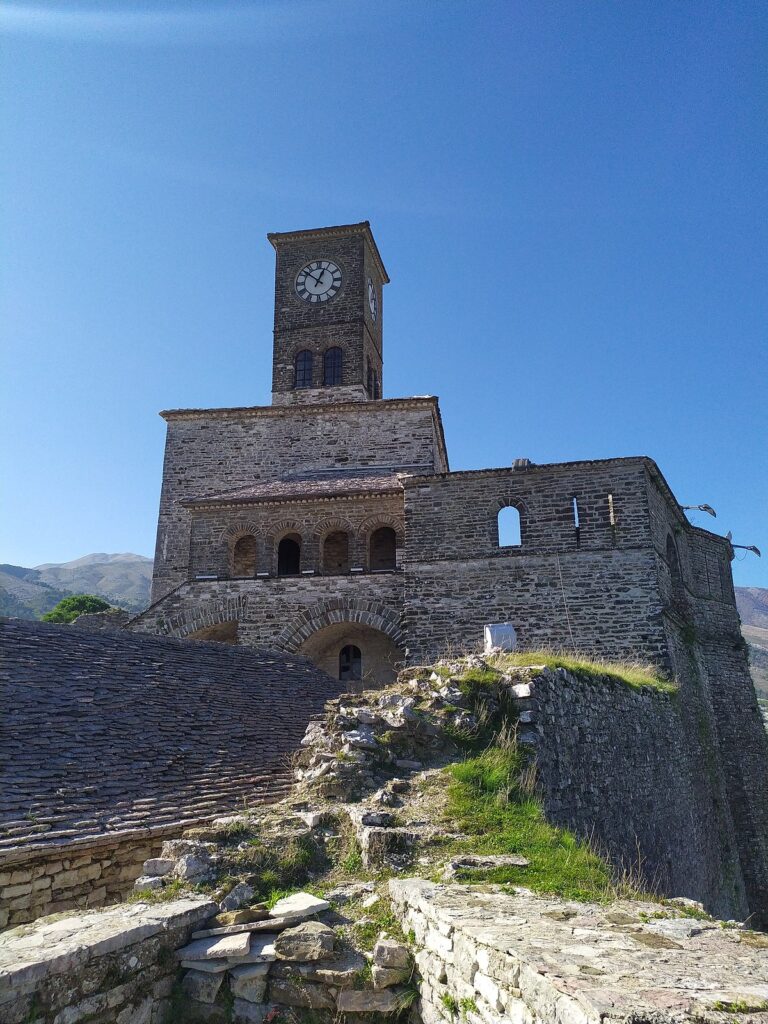
In 1812, Gjirokastër Castle was dominated by Ali Pasha of Tepelena, who began its reconstruction; specifically, a seraglio and several annex buildings. The reconstruction of the castle was completed very quickly, with all the work being done within a year and a half.
The castle contained, apart from barracks for the placement of a garrison of 5,000 soldiers, numerous underground magazines, which were well-calculated for securing necessary munitions and food supplies. During World Wars I and II, it served as a shelter for the city’s inhabitants to protect them from aerial bombardments.

Rozafa Castle
Rozafa Castle is of Illyrian origin and its name “Rozafa” comes from the medieval period. A legend is also connected with this name, which speaks of one of the most sacred virtues of the Albanian, which is “besa – keeping one’s word”. The content of the legend is related to the wall of Rozafa, the daughter-in-law of the younger brother of the three brothers, who built the walls of the castle during the day and they were destroyed at night. At the entrance to the castle there is a bas-relief of Rozafa. The limestone water flowing in the main entrance represents the breast milk that, according to the narrator, was left outside for Rozafa to feed the child. The castle was given its present form by the feudal family of Balshaj, during their rule during the 14th century, but today most of the castle belongs to the Venetian period. Also, the Ottoman occupation has left its mark.
Rozafa is one of the most important forts in Albania and serves as the main tourist object of the city of Shkodra. Visitors can learn about the history of the city, various events and important personalities, through engravings, reproductions of archival documents and works of art from different times. By visiting this fort, in addition to the fantastic scenery, you can enjoy the natural phenomenon of the meeting of rivers and touch the history with your hands.
Customise your Albanian tour now!
Other Destinations
Kruja Castle
Kruja Castle is one of the most popular castles in Albania. This elliptic-shaped fort occupies an area of 2.5 ha of land and is built on a rocky hill. Kruja Castle was built during the 5th and 6th centuries. Its surrounding walls are reinforced by 9 towers which served for observation and receiving signals from Petrela and Durrës Castles, during periods of war.
The castle is the main tourist object of the city of Kruja. In addition to the stands that explain the activity of Skenderbeu, with the aim of protecting Albania from the Ottoman invasion, in the museum you will also find a bookstore, documents and publications related to the personality of Gjergj Kastriot. The museum has a commemorative nature with elements such as stone arches, glass photos. Inside the walls of the castle there are still houses where only some of them are alive, there is also the small mosque of Dollma, and even in the western part of the castle there is also the hammam of the XV century.
In addition to the castle, another element that attracts tourists is the road that leads to the castle, along which the old medieval bazaar of Kruja is located, where the main feature is the cobbled street and the shops built with wood.
Here, in addition to the beautiful landscape, tourists can find many objects and souvenirs such as handicrafts of filigree, alabaster, silver, copper, woodwork, wool carpets, antiques and many other very interesting creations.
The history of this castle makes it one of the most popular and most visited places by tourists even today.

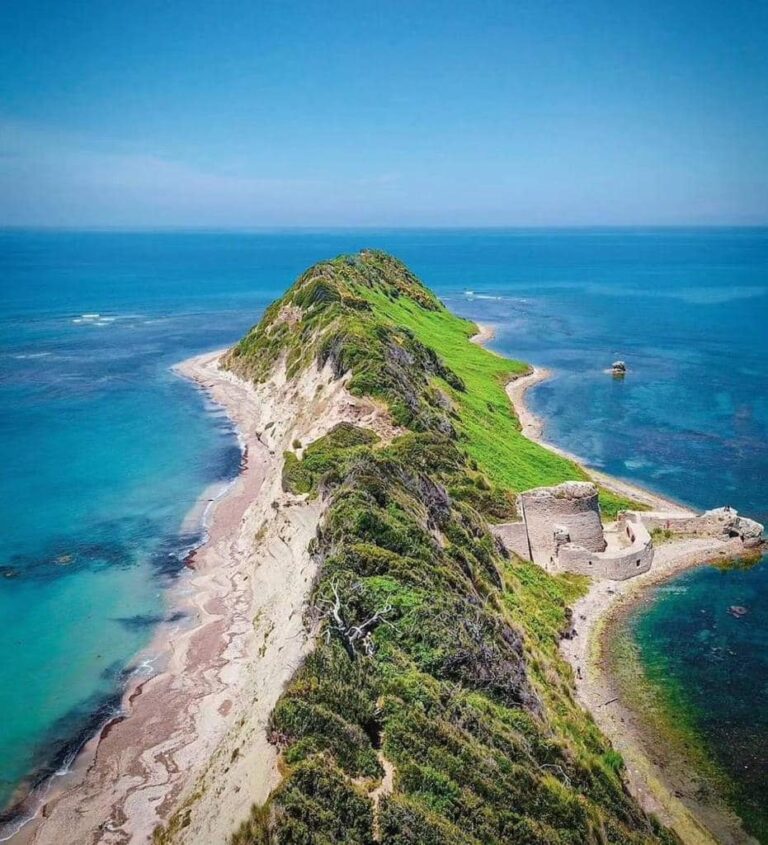
Rodon Castle or Skanderbeg Castle
Rodoni Castle or as it is otherwise known as Skënderbeu Castle, a cultural monument of the first category, is one of the most beautiful touristic and historical stations of Albania. This castle, which is located on the Rodon cape, was built right here at the request of the Albanian national hero Skënderbe, aiming to have a close outlet to the sea.
The castle began to be built after the first siege of Kruja in 1452, and the perimeter of the wall reaches 400 m in length and at each of its corners a tower. As a result of the erosive activity of the sea waters, part of the walls of the fortress are submerged in the Adriatic Sea. Today, visitors can easily see the outer walls of one side, which end with a round tower. Very close to the castle are the ruins of St. Peter’s church, which is considered a holy place by the residents and an attraction for tourists, inside which there is the original flag painted on its walls, and many other writings designed by former soldiers of the coastal battery department, since the time of communist rule.
Petrela Castle
Petrela Castle is located along the national road Tirana – Elbsasan, 17 km from Tirana, and offers a breathtaking panorama of the Erzen valley, the surrounding hills and mountains. The castle rises to a height of 400 meters, the unique triangular shape of the castle is decorated with two circular towers on the side, as proof of its historical importance. It is one of the most important tourist centers of Tirana. The castle is built on top of a rocky hill in the village of the same name. It has a triangular shape with two observation towers. The first construction of the castle dates back to the period of antiquity, while the present form dates back to the 15th century. Petrela Castle was part of the defense and signaling system of Kruja Castle, where these two castles communicated with each other through the exchange of messages by fire. During Skanderbeg’s wars against the Ottomans, Petrela Castle was placed under the command of Mamica Kastriot, Skanderbeg’s sister. Today, inside the castle grounds there is a restaurant that is very frequented and stands out for its hospitality and good service to visitors, rich traditional food, which is very tasty and preferred by many visitors. From here also unfold the beautiful landscapes that include the valley of Erzen, the hills with olives and the surrounding mountains. Petrela Castle presents a rich treasure of cultural, material and spiritual heritage of different historical periods. Today, it stands as a symbol of history. and beauty.
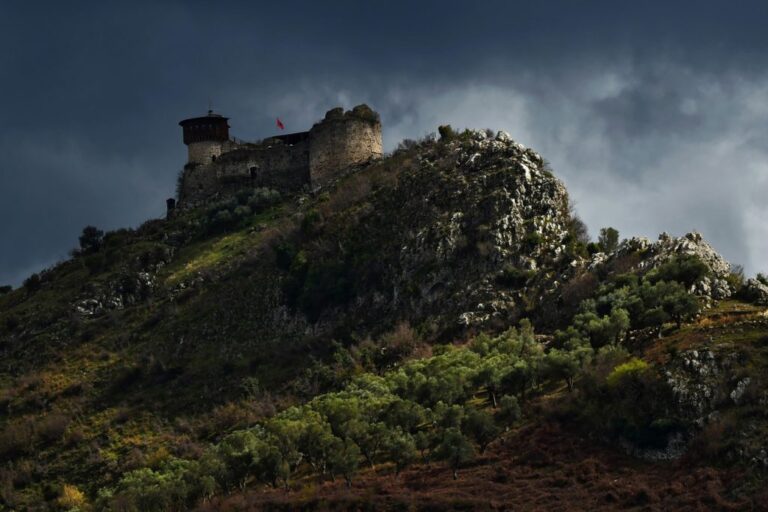

Bashtova Castle
Where the roads between East and West crossed in the years of the Roman Empire, Bashtova Castle rises, one of the monuments of our historical heritage, which for centuries has attracted the attention of local and foreign researchers.
This castle is located near the village of Bashtovë, at a distance of 3-4 km in the northern part of the Shkumbin estuary. The castle was built during the 15th century and was at the service of the Venetians. Due to its geographical position, as the only Balkan castle that rises above a plain area, the Bastova castle has been on the list of places waiting to become part of the UNESCO World Heritage for many years.
Bashtova Castle is located a few kilometers from Kavaja, near the beautiful coast of Spille, Gredhi, Divjaka and Shkumbin river.
The 500-year-old castle is a beautiful testimony of the civilizations through which Albania has passed. The environment surrounding the centuries-old castle is a national natural park suitable for fishing, hiking and recreational outdoor activities.
Borsh Castle (Sopot Castle)
One of the most important historical sites in Borsh is the Castle of Sopot, located on the hill of the same name, 500 meters above sea level. It was built in the 4th century BC by the Illyrian-Epirote tribes. This hill has rocky terrain, and on the west side, there are several terraces where remnants of medieval buildings can be observed. Ruins of ancient walls are also visible on the southwestern side, approximately 10 meters in length and 1.33 meters in height. Borsh Castle was a highly coveted fortress due to its strategic location. From its summit, one can observe mountains, villages, and the sea, while from a touristic perspective; the view from this position is spectacular and magical.
The Castle of Sopot has been declared a Cultural Monument and is open to local and foreign visitors every day of the year.

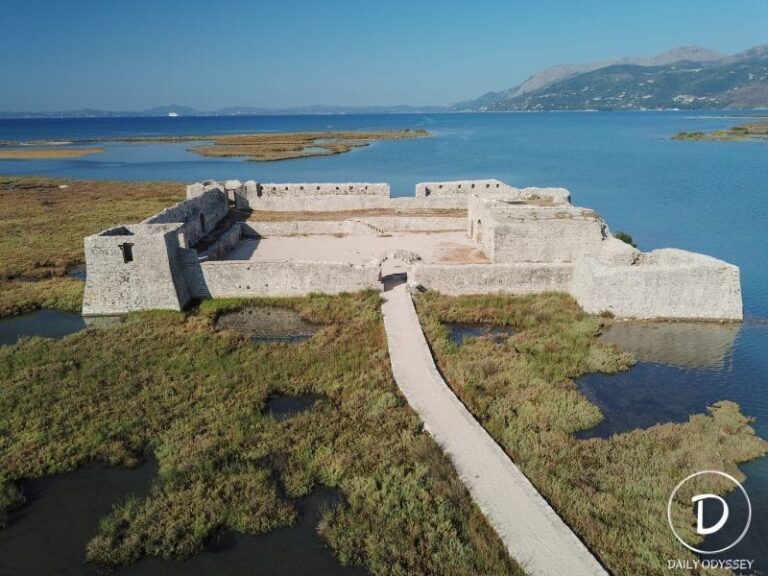
Ali Pasha’s Castle in Butrint
Ali Pasha’s Castle is another fortress named after the ruler Ali Pasha of Tepelena in Albania. Ali Pasha resided there until 1820. The present castle was rebuilt in 1819 and has three towers on its surface. Until 1820, it was Ali Pasha’s second residence. Known and depicted in paintings as the Triangular Castle, it was built during Venetian rule in the late 15th or early 16th century. It served as a fortress for the Venetians in Corfu to exploit fishing, pastures, olive groves, and timber around Butrint. The fortress was a center of numerous conflicts with the then-rising Ottoman Empire, so it fell under the control of various invaders to prevent its capture by Ali Pasha.
The fortress in Butrint is located about 2.4 kilometers west of the mouth of the Vivari Channel. This castle dates back to the late 17th or early 18th century as a fortified center owned by a family from Corfu cultivating lands in the field south of the ancient city.
Ali Pasha took control of the structure around 1804 and carried out a series of works to improve its defenses, including installing cannon batteries. Given its small size, the castle functioned as a fortress controlling the sea exit at Butrint and cannot be compared to Ali Pasha’s more powerful castles in the Tepelena, Gjirokastër, and Ioannina areas.
The Vivari Castle in Butrint
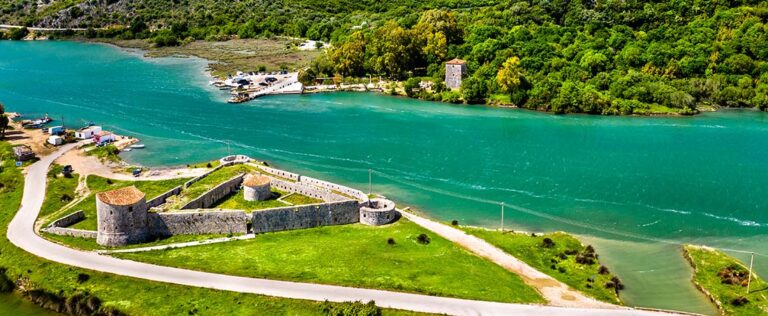

The Small Castle of Porto Palermo
The small castle of Porto Palermo is situated in a beautiful location on a peninsula in the small tectonic bay of Porto Palermo, known in antiquity as the bay of Panormos. The castle is located a few kilometers away from the village of Qeparo and has a triangular shape. Its dimensions are 150 m x 400 m, and the height of the walls reaches 20 m. From the castle, visitors can enjoy the enchanting view of the elite bay of Porto Palermo.
The castle is located on an islet about 30 m away from the Ionian coast, where the narrow water strip between the shore and the islet has been filled with soil and stones to create a land connection to it. The castle has a triangular planimetric shape with three bastions at its corners. The entrance is located in the middle of the southern wall. From the sea side, between two bastions, a trapezoidal area is surrounded by walls equipped with embrasures. The rest of the castle consists of a large number of rooms covered with arches, which end at the top with a common terrace.
These spaces served as accommodation for the garrison, while one of them served as a prison.
The Porto Palermo Castle is one of the many residences of the strategist Ali Pasha of Tepelena, which he purposefully built in strategic locations. However, this fortress stands between the sea and legend, as it was built by Ali Pasha as a gift for one of his wives, Vasilica, whom, according to chroniclers of the time, the Pasha of Ioannina held very dear. The beauty and grandeur of this castle have been captured in many books dedicated to Ali Pasha.
Among others, Alexandre Dumas, the author of “The Count of Monte Cristo,” wrote about it. Built about two centuries ago entirely of stone construction, the castle of Porto Palermo is one of the most visited monuments by foreign and Albanian tourists.
Lëkurësi Castle
Lëkurësi Castle is located about 2 km south of the city of Saranda. The castle is situated on a very high hill, offering a fantastic view of the Saranda bay and the island of Corfu across the horizon.
The castle has a rectangular shape, with a tower at each corner. According to some sources, the castle was built in 1537 by Sultan Suleiman during his conquest campaign on the island of Corfu.
The hill of Lëkurësi, on top of which the castle is located, can only be reached via a small road that winds around the back of the hill.
The castle is approximately 3 to 4 kilometers away from the center of Saranda, and if you decide to walk up the hill, it will take you about 45 minutes to an hour. The road is paved and in good condition, and there are parking opportunities. Around the castle, remnants of the old village of Lëkurësi can still be found. At the main gate, some 20th-century artillery pieces are also displayed.
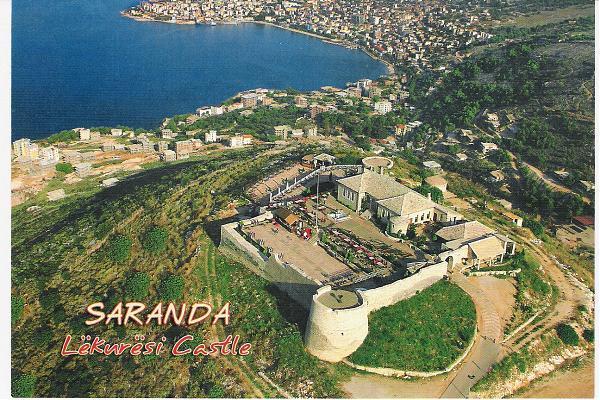
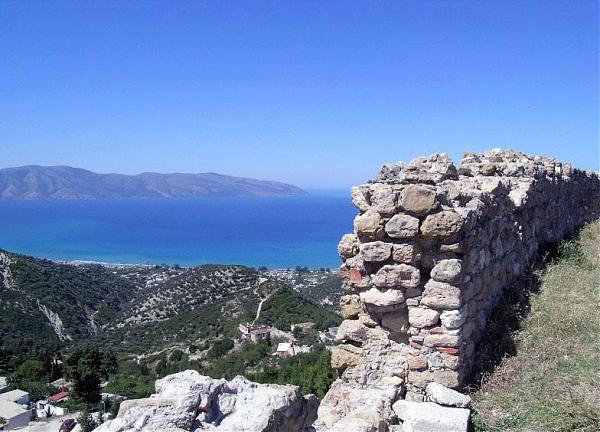
Kaninë Castle
This castle is located 6 km away from the city of Vlorë. It is mentioned as early as the 4th century, although traces of the Illyrian period have also been discovered. The castle is believed to have been built in the 3rd century BC. Later signs belong to the Byzantine, Venetian, and Ottoman periods.
The castle was rebuilt by Emperor Justinian in the 5th century AD and later repaired by Sultan Suleiman in 1531. It is situated on the top of a hill 380 meters above sea level and covers an area of 3600 m2.
The castle offers beautiful views of the city and the bay of Vlorë.
Kaninë Castle is one of the most attractive tourist destinations dedicated to historical and cultural tourism in the city of Vlorë.
Himara Castle
According to ancient evidence, Himarë Castle dates back 3,500 years. In medieval times, during the Byzantine period, a small city-castle existed in place of the current castle.
The castle is bordered by two canyons, Vishë to the northwest and the Osë stream or Kole Midharit canyon to the southeast. Known also as Barbaka, it is built on a rocky hill. Himarë Castle has existed at least since the middle of the 4th century BC and controlled the coastal road from Orikos to Buthrotos (Butrint).
Himarë is mentioned in several ancient writings. In the 1st century BC, the Greek geographer Strabo provided a detailed description of the Adriatic and Ionian coasts. Among other things, he wrote, “In the Akrokeraune mountains is the castle of Himarë and the source of royal water.”
In the list of fortified places in Epirus provided by English researcher N. Hammond, Himarë Castle is noted as a fortress with surrounding walls between 500 – 1000 m in length.
In the 8th century AD, Himarë Castle became the center of the Himarë Bishopric, indicating its importance in the Ionian Riviera. For this reason, the entire region encompassing the coast, Kurvelesh area, Vlorë River, and Tepelenë was named Himarë.
Traces from all historical periods are preserved within the castle, such as the surrounding walls of the Hellenistic period. The large polygonal stone blocks are similar to the surrounding walls of Phoenice, Butrint, and other cities of Chaonia from the same period.
Inside the castle walls, there are several churches, including the Church of the Episcopate, considered one of the most important monuments and located within the Hellenistic walls. It is thought that the castle was built on the foundations of a temple dedicated to Apollo. The architectural ensemble of Himarë Castle has been declared a Cultural Monument.
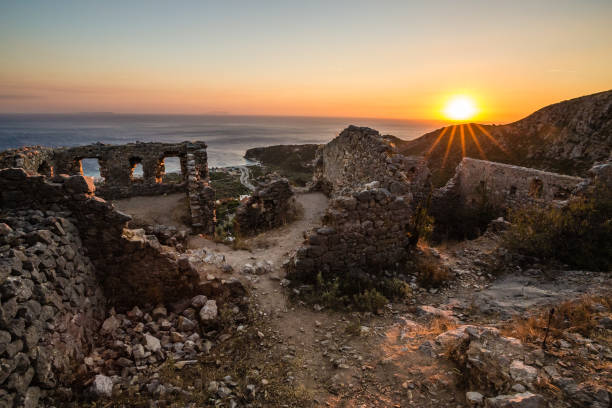

Berat Castle
Berat Castle is situated on the right side of the Osum River gorge, on a hill 187 meters above the river level. The castle is the crown of this ancient city.
From the fortified courtyard of the castle, one can see the entire city of Berat, the Osum River, and the old Gorica Bridge. The castle is one of the most beautiful, largest, and most significant monuments of Albanian history and culture.
Originally a protourban settlement in the 7th-5th centuries BC, as an important strategic point, it was transformed into a city-castle with walls that reached a length of up to 1400 meters. Historical sources indicate that Berat Castle has been the target of various attacks since that time.
Various historical documents mention a series of names. Known as Antipatrea in 216 BC, it was called Albanorum oppidium (fortress of the Arbërs) by the Romans.
Berat Castle was equipped with 24 towers, and along with the walls, they belong to different construction periods starting from the 4th century BC and ending during the reign of Ali Pasha Tepelena in the years (1813-1821).
Within the castle’s 9.6-hectare area, there are several churches, out of the 30 that once existed, which began construction from the 15th century, such as the Church of St. Todri, the Church of St. Mary of Vllaherna, and the Cathedral “Dormition of St. Mary,” among others.
The castle is located at the highest point of the historical center and is one of the few medieval period monuments in Albania that continues to have an intensive life within its surrounding walls.
For all local and foreign visitors, Berat Castle is an extraordinary historical and cultural monument and a remarkable tourist attraction.
Customise your Albanian tour now!
Other Destinations
Get in touch with our friendly team
- contact@absolutealbania.com
- +355 67 40 567 56
